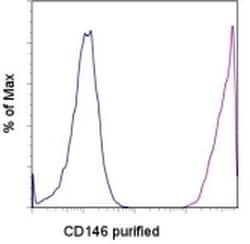Learn More
Invitrogen™ CD146 Monoclonal Antibody (P1H12), eBioscience™, Invitrogen™
Mouse Monoclonal Antibody
Supplier: Invitrogen™ 14146995

Description
The MAb P1H12 recognizes CD146 also known as MUC18, s-endo, Endo-CAM and Mel-CAM, which is a member of the Ig superfamily of proteins. The expression of CD146 is found on endothelial cells, bone marrow fibroblasts and some tumors (especially melanoma). Recently mesenchymal stromal cells and endometrial stromal cells have also been shown to express CD146. The presence of CD146 on circulating blood cells have been confined to a subset of T cells rather than circulating endothelial cells, as expression of other endothelial markers (CD31 and CD51/61) is negative. Expression can be found on activated lymphocytes. The protein is heavily glycosylated with more than 50% of the mass from carbohydrates. The antibody P1H12 has been reported to crossreact to mouse, rabbit, canine, but not rat.
CD146, also known as MCAM (Melanoma Cell Adhesion Molecule), is an integral membrane glycoprotein belonging to the immunoglobulin superfamily. It is heavily glycosylated, with more than 50% of its mass derived from carbohydrates. CD146 is primarily expressed on endothelial cells at cell-cell junctions, playing a crucial role in cell adhesion and the cohesion of the endothelial monolayer in vascular tissue. In addition to endothelial cells, CD146 is expressed on bone marrow fibroblasts, mesenchymal stromal cells, endometrial stromal cells, and some tumors, particularly melanoma. It has also been observed on a subset of circulating T cells and activated lymphocytes, but not on circulating endothelial cells, as indicated by the absence of other endothelial markers such as CD31 and CD51/61. CD146 functions as a calcium-independent cell adhesion molecule and may also act as a signal transduction molecule. It is involved in the recruitment of Fyn kinase and the subsequent tyrosine phosphorylation of intracellular proteins, which are important for actin cytoskeleton assembly. This signaling role includes triggering tyrosine phosphorylation of FYN and PTK2 and causing a transient increase in intracellular calcium concentration. In the context of cancer, CD146 expression may facilitate the interaction of melanoma cells with the vascular system, enhancing hematogenous tumor spread. Additionally, CD146 could serve as an adhesion molecule active in neural crest cells during embryonic development, highlighting its diverse roles in both normal physiological processes and disease states.
Specifications
| CD146 | |
| Monoclonal | |
| 0.5 mg/mL | |
| PBS with 0.09% sodium azide; pH 7.2 | |
| P43121, Q8R2Y2 | |
| MCAM | |
| Affinity chromatography | |
| RUO | |
| 100342848, 4162, 489368, 84004 | |
| 4°C | |
| Liquid |
| Flow Cytometry, Immunohistochemistry (Frozen), Immunoprecipitation, Western Blot | |
| P1H12 | |
| Unconjugated | |
| MCAM | |
| 1-gicerin; AV025631; CD146; CD149; Cell surface glycoprotein MUC18; cell surface glycoprotein P1H12; Gicerin; HEMCAM; l-gicerin; l-gicerin precursor; l-gicerin protein; LOW QUALITY PROTEIN: cell surface glycoprotein MUC18; MCAM; melanoma adhesion molecule; melanoma cell adhesion molecule; Melanoma-associated antigen A32; melanoma-associated antigen MUC18; Muc18; mucin-18; s-endo; S-endo 1 endothelial-associated antigen; s-gicerin; s-gicerin precursor | |
| Mouse | |
| 10 mg | |
| Primary | |
| Human, Mouse, Canine, Rabbit | |
| Antibody | |
| IgG1 κ |
The Fisher Scientific Encompass Program offers items which are not part of our distribution portfolio. These products typically do not have pictures or detailed descriptions. However, we are committed to improving your shopping experience. Please use the form below to provide feedback related to the content on this product.
